What Is The Best Indoor Garden
Over the past year, the hardships and food insecurity brought on by the coronavirus pandemic sprouted a rise in so-called "victory gardens" — referencing the wartime effort to contribute food during the World Wars — even for those with limited outdoor space. Whether due to financial difficulties or strict lockdown orders across the country, more than one fourth of American consumers said they planted a food garden because of the pandemic, according to a 2021 survey by market research outfit Packaged Facts. And for those who don't have the luxury of a sunny backyard space, an indoor garden is just as likely to flourish as one outdoors.
LEARN MORE How to start (and maintain) an indoor garden
Indoor gardening kits can be a fairly painless and efficient way of exercising your newfound green thumb. Many come with all of your indoor gardening essentials already built in, including grow lights, self-watering containers and auto-timers, to name a few. To help guide indoor gardening beginners (or anyone thinking of gifting one of these devices), we consulted experts to learn the basics of indoor gardening and what to look for when choosing the right gardening system.
Why start an indoor garden?
The concept of indoor gardening is pretty straightforward — it's the act of growing produce inside your home, either due to a lack of outdoor space, cold temperatures that prevent certain produce from growing or the desire to pick fresh food from the comfort of your kitchen. Not only can gardening be a relaxing and often rewarding hobby, it can also provide you with the freshest produce all year — no supermarket runs for each meal. Indoor gardens also give you total control over a plant's growth and its environment, for better or worse.
"Very little nutrients are lost from harvest to consumption in the indoor garden," said Julie Bawden-Davis, a master gardener behind the site Healthy Houseplants and author of "Indoor Gardening the Organic Way." "Plus, there is nothing quite so exciting as seeing seeds start to sprout in your indoor garden and then watching them grow into plants and produce edible fruits and veggies."
Many types of produce can be grown indoors, from fruits and vegetables like cherry tomatoes, peppers and microgreens to fresh herbs like thyme, parsley and rosemary. Experts told us the key factor is lighting; it can be difficult getting enough sunlight for plants to grow indoors — even if they have enough soil, many plants grow thin and weak without enough light, if they even grow at all.
"Other factors, such as proper watering or fertilizing, can be more easily learned and manipulated, but without the correct amount and type of light, plants won't thrive," said Bawden-Davis, adding that most indoor gardening kits come with built-in full-spectrum LED lights that simulate daylight and lead to plant growth.
An indoor garden does have its limitations, of course. Experts told us cauliflower, Brussels sprouts, kale, broccoli and cabbage, which typically thrive in colder temperatures, don't usually grow well indoors. Larger vegetables that need a lot of room to grow, such as pumpkins and watermelon, are also difficult to grow indoors.
Best indoor gardening kits of 2021
Based on expert guidance and our past coverage, we've compiled the best indoor gardening kits and systems to get started.
AeroGarden Harvest Elite
"In my opinion, [AeroGarden] has the most advanced technology, especially in the area of lighting and hydroponics," said Bawden-Davis.
The AeroGarden Harvest Elite lets you grow fresh herbs and vegetables during any season without needing an outdoor space or direct sunlight. It features a stainless steel base that uses a hydroponic growing system, along with high-performance LED grow lights that are automatically turned on and off via a customizable timer. The 6-pod herb seed kit includes thyme, curly parsley, dill, Thai basil, Genovese basil and Mint, and the all-natural liquid plant food is non-GMO and free of any pesticides and herbicides. The digital display automatically reminds you when to add water and plant food.
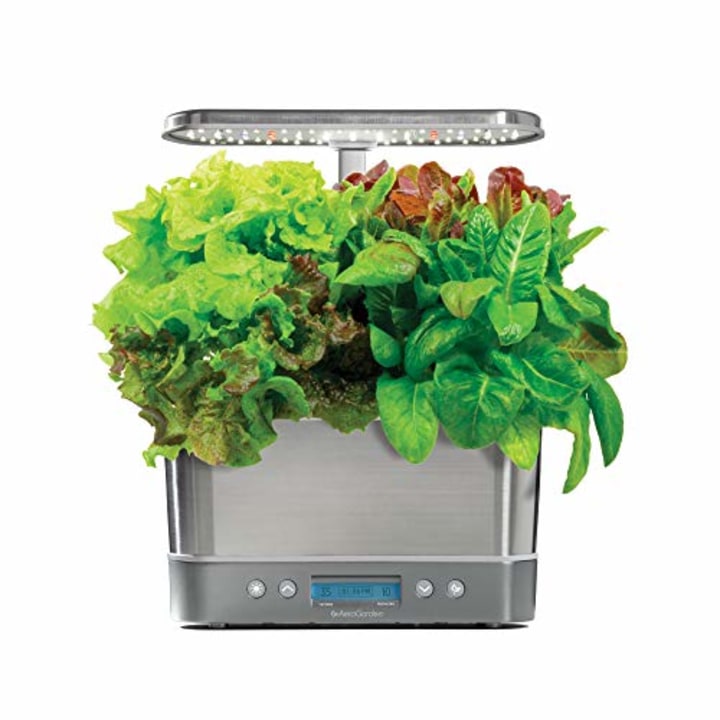
Click & Grow The Smart Garden 9
This soil-based system features an automatic watering planter and built-in LED grow lights. You can choose from more than 60 pre-seeded biodegradable plant pods (or use your own seeds) and insert them into the planter. You then add water into the tank — which holds enough of it for up to a month — and use the water float indicator to monitor the overall water level over time. It comes with nine complimentary plant pods: three mini tomato, three green lettuce and three basil pods.
If you're hoping for a more app-savvy gardening system, the brand released The Smart Garden 9 PRO, which allows for app-controlled grow lights and schedule.

Rise Gardens Single Family Garden
This smart, hydroponic garden by Rise Gardens can serve as both an indoor gardening system and a stylish piece of furniture. It features a five-gallon water tank and is self-watering, requiring about three gallons of water per week, according to the brand. The water levels, LED grow light settings and nutrient levels can all be monitored and controlled through a mobile app, which can help you keep track of your plants, know what to do at each stage of growth and remind you when to add water and nutrients. The system comes with 16 seed pods, including lettuce, arugula and red pepper, and the pod tray can hold up to 12 plants. You can make your garden larger by adding a vertical extension, which can add up to three levels.
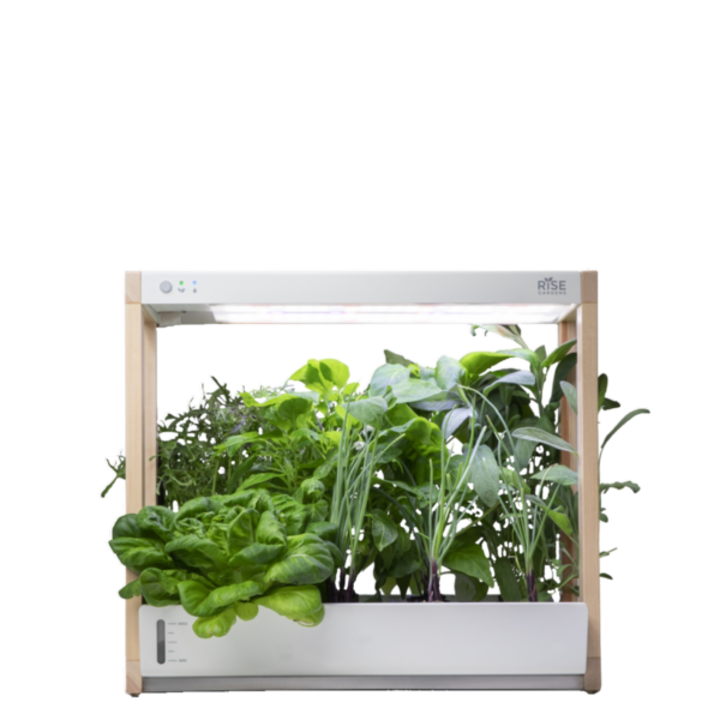
Lettuce Grow The Farmstand
Lettuce Grow's The Farmstand is a self-watering and self-fertilizing hydroponic system, which grows plants in nutrient enriched water without soil both indoors (with the separate purchase of LED grow lights) and outdoors. It's made with recyclable packaging and available in five different sizes ranging from a 12-plant capacity to a 36-plant system, and you can grow a variety of non-GMO vegetables, herbs and leafy greens of your choice. The brand suggests adding water to the reservoir, adding nutrients and testing and adjusting the pH levels once a week. The Farmstand can also be assembled in under ten minutes and takes about five minutes to maintain each week, according to the brand.
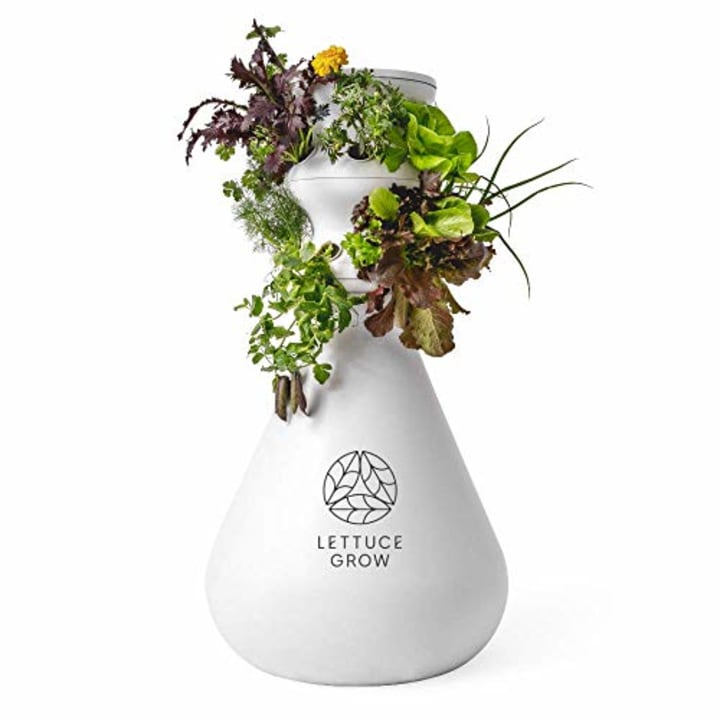
Tower Garden FLEX Growing System
Jenn Frymark, chief greenhouse officer of indoor farming company Gotham Greens, recommended this system, which she said is used by some of their community partners, including the Green Bronx Machine.
The Tower Garden FLEX is a vertical garden that uses an aeroponics system, in which a low-wattage, submersible pump pushes a nutrient solution to the top through a small central pipe and the solution drips down the inside of the Tower Garden, evenly pouring over the exposed plant roots. It includes a seed starting kit that includes a germination tray, net pots, a variety of starter seeds and rockwool cubes, which is used as a medium instead of soil and planted in your indoor Tower Garden about three weeks after germination, according to the brand.
This system doesn't include LED grow lights, so they need to be bought separately for indoor use.
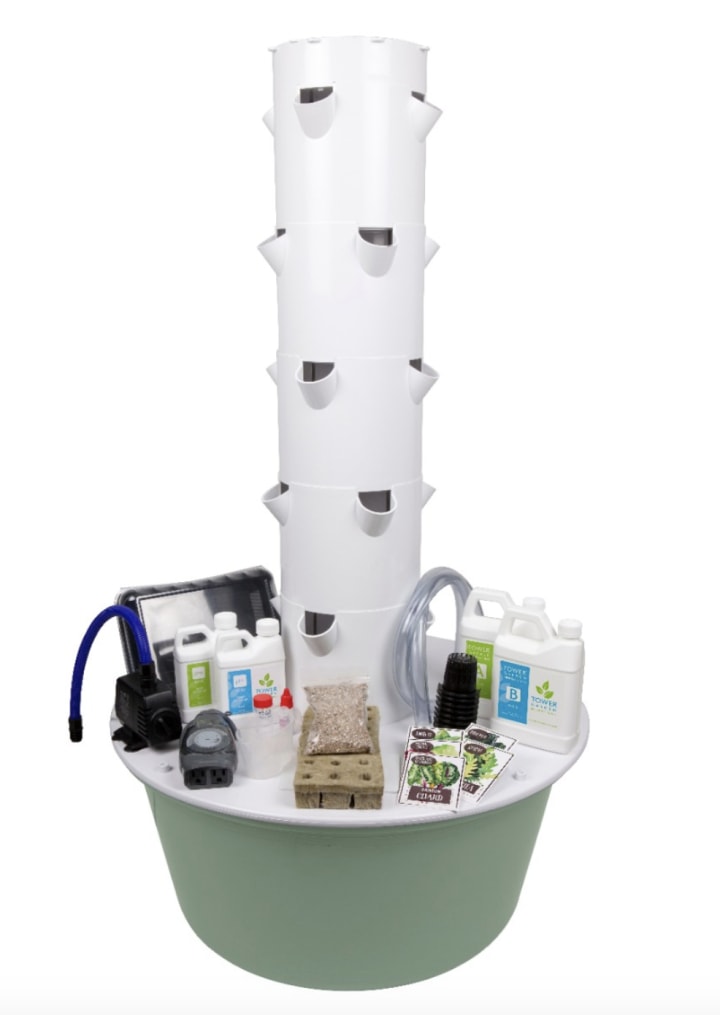
Back to the Roots Water Garden
Using an aquaponics system, the Back to the Roots Water Garden is essentially a self-cleaning fish tank that grows microgreens and wheatgrass at the top. You can either choose to add a Betta Fish — the set provides a coupon to buy one — or maintain a hydroponic system by utilizing the water in the tank. The kit includes microgreen seeds, fish food, a natural dechlorinator to keep the water safe for fish and growstones to use as a growing medium for the plants.
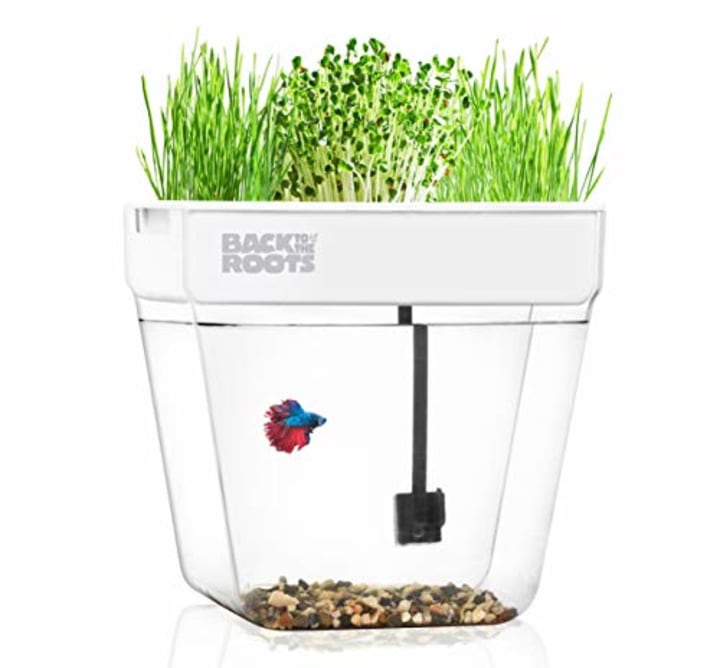
Indoor gardening systems: A shopping guide
Before starting your indoor gardening journey, experts recommend considering the various types of growing systems available, along with how much time and space you're willing to dedicate to your garden.
What growing systems do indoor gardens use?
There are three main growing systems that indoor gardening kits use: soil-based, hydroponic, aquaponic and aeroponic systems.
- Soil-based systems are similar to growing plants in an outdoor garden — they contain pods with traditional potting soil that you can plant seeds into and water periodically.
- Hydroponic systems supply a nutrient-rich solution to the plant's roots instead of using soil. Jacob Pechenik, co-founder and CEO of Lettuce Grow, said these typically use less water than soil-based systems because they don't "create runoff or water larger-than-necessary areas."
- Aquaponic systems are similar to hydroponics, but use live fish in the water — the fish's waste provides nutrients that helps plants grow, mimicking a natural ecosystem.
- Aeroponic systems is a more advanced form of hydroponics, using air or mist environments rather than soil. These systems spray nutrient-rich water on the plant's exposed roots, while hydroponic systems require plants to grow in the solution.
What size should your indoor garden be?
The size of indoor gardening systems can vary, and experts recommend sticking with what fits your indoor space and expertise level. Most indoor gardening systems, including larger options, only take up a few square feet of space — rendering them compact enough for urban dwellers. Some seed pod gardens, like the AeroGarden Harvest, are typically more compact, portable and lightweight — larger systems like Rise Gardens take up a lot more space but can grow more plants at once.
Angela Judd, founder of the blog Growing in the Garden and author of "How to Grow Your Own Food" suggested first-time gardeners should choose a small system to get started so they're investing less to see whether "it is something that they'll enjoy using" over time.
What types of plants can you grow?
Some indoor gardening systems are designed to only grow certain types of plants — a system for growing lettuce or microgreens may be different than one that grows tomatoes — and Frymark suggested doing research on what you can to grow before investing in a system. Depending on your space and budget, you can use the pre-seeded pods that come with your kit or choose what you grow by purchasing pods separately.
"It's important to establish your priorities and goals and how those match up with your living space and how much time and effort you want to put into maintaining your indoor garden," she said.
Do you need grow lights?
Many, but not all, indoor gardening systems already include grow lights. "Your room might seem bright and sunny to you, but many energy-efficient windows don't allow the full spectrum of light to pass through, so your plants will behave as though they're growing in the shade," explained Pechenik. "This could lead to stretched plants that struggle to reach their full potential."
Frymark noted certain plants (like basil and chives) do well with lots of sunlight, while others will require lower light levels. If a sunny spot isn't available in your home, LED grow lights mimic normal sunlight and allow the plants to photosynthesize. Some systems even include dimming features along with automatic timers that'll keep the grow lights on for the majority of the day.
Maintenance level
Depending on the features, some indoor gardening systems require higher maintenance than others, from frequent watering or to regular soil upkeep.
"If you're just starting out, it's best to keep it simple and relatively low maintenance and work your way up from there," said Frymark.
If your system is soil-based, Judd recommended investing in a self-watering option that keeps the soil from drying out. A built-in irrigation system paired with LED light rings that operate on timers make for little maintenance during the week while still letting your garden thrive — it likely means a higher price point, too. There are also many smart garden options that come with growing supplies like seeds and fertilizer, so you won't have to run to the store for additional growing materials.
Additional indoor gardening tips
If it's your first time setting up an indoor garden, experts shared with us some tips to keep it healthy and thriving no matter the time of year.
Keep your indoor garden close to the kitchen, or its final destination.
"Placing it close to the kitchen and in an area that you pass by daily ensures that you'll always be observing and monitoring your plants to keep them growing strong," suggested Lettuce Grow's Jacob Pechenik.
Grow the smaller versions of plants when growing indoors, like cherry tomatoes, baby carrots and beets. "You'll have more luck getting such fruit and veggies to grow to a good size for eating," said Healthy Houseplant's Julie Bawden-Davis.
Spend a minute or two each day paying attention to your plants. "It's easy to catch problems when they're small," said Judd. "Even 'no work' indoor gardens benefit from a caring gardener."
Make sure to match your produce with the conditions of your environment. If you don't have grow lights but have a window that gets direct sunlight for many hours each day, choose a plant that would thrive in those conditions, like herbs or tomatoes.
"Try to avoid plants that benefit from pollination and need to spend some time outdoors," said Frymark, adding that, if you have outdoor space, you can put plants like daisies and lavender around your garden that will attract pollinators.
Keep an eye out for any indoor pests and use only organic means of controlling them, noted Bawden-Davis.
"The sooner you deal with a pest invasion, the better chance you'll have of getting it under control," she said. "Keep in mind that healthy plants tend to ward off pests and diseases, so make sure you're watering only when the plants need it and provide proper lighting and regular fertilizing."
Catch up on Select's in-depth coverage of personal finance, tech and tools, wellness and more, and follow us on Facebook, Instagram and Twitter to stay up to date.
What Is The Best Indoor Garden
Source: https://www.nbcnews.com/select/shopping/best-indoor-garden-kits-ncna1267376
Posted by: tathamferamplon.blogspot.com

0 Response to "What Is The Best Indoor Garden"
Post a Comment